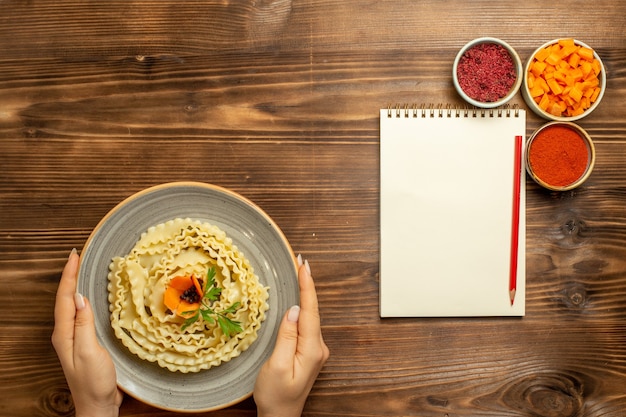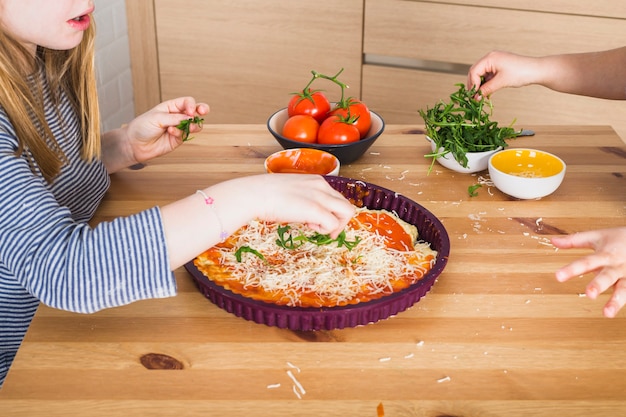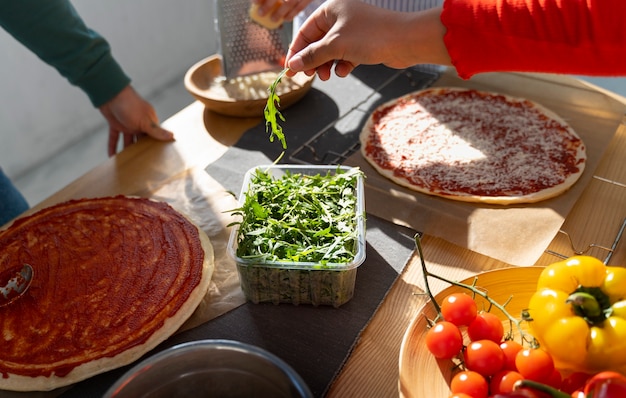Ah, lasagna. It's a dish that evokes warmth and comfort, a symphony of flavors and textures. Whether it's a classic Italian recipe passed down through generations or a modern twist on the traditional, lasagna is a crowd-pleaser, always welcomed with open arms (and hungry stomachs). But getting that perfect bake – the kind where the pasta is al dente, the cheese is bubbly and golden, and the sauce sings with flavour – can feel like a culinary quest. One of the most frequent questions I get asked is, "How long do I bake this thing for?" And you know what? It's not as simple as setting a timer and hoping for the best. There's a bit of an art to it, a dance between heat, time, and the magic of ingredients.
Over the years, I've tried countless lasagna recipes, experimenting with different baking times and techniques, each attempt a lesson learned. I've had triumphs that would make a nonna proud, and some unfortunate disasters (a burnt lasagna is a culinary tragedy, let me tell you!). But through it all, I've learned the secrets to a consistently delicious lasagna, and I'm ready to share them with you. So, buckle up, grab a spoon, and let's dive into the world of lasagna baking, where time is of the essence, and a perfect bake is the ultimate reward.
(Part 1) The Importance of Baking Time

The baking time for lasagna isn't a one-size-fits-all situation. It's like finding the perfect pair of jeans: it depends on a few key factors. First, there's the size of your dish, which dictates how much surface area the lasagna has to bake. Then, there's the type of pasta you're using; fresh pasta cooks faster than dried pasta, so the baking time will vary. Finally, the amount of cheese you're layering on top plays a role too. But, generally, you're looking at a good 30-45 minutes in a preheated oven. Yes, that might seem like a long time, but trust me, it's essential for that magic to happen. It's the time needed for the pasta to cook through, for the cheese to melt into a glorious, bubbly crust, and for the sauce to simmer and meld into a harmonious symphony of flavor.
Why Baking Time Matters
Think about it this way: no one wants a soggy lasagna. That's where baking time steps in as a culinary hero. A proper bake allows the lasagna to dry out slightly, giving those pasta sheets that perfect al dente texture, that delightful bite. It also ensures that the cheese has ample time to melt and create that golden, bubbly crust that we all crave. It's the difference between a lasagna that's a delicious indulgence and one that's a soggy, disappointing experience.
How to Tell if Your Lasagna is Done
Just relying on the timer won't cut it. You need to become a lasagna detective, using your senses to unlock the secrets of a perfectly baked dish. A good rule of thumb is to stick a knife or skewer into the center of the lasagna. If it comes out clean, it's done. If there's still some uncooked pasta clinging to the blade, pop it back in the oven for a few more minutes. Another way to tell is by looking at the cheese. It should be bubbly and golden brown, a sign that the heat has penetrated through the layers and cooked the lasagna to perfection.
The Trick to a Perfect Bake
Here's a little secret that I've learned over the years. To ensure an even bake, cover the lasagna with foil for the first 20-25 minutes. Think of it as a culinary hug, protecting the delicate layers underneath. This allows the pasta to soften, the cheese to melt without burning, and the sauce to simmer gently. Once the pasta is cooked through, remove the foil, and let the top bask in the heat, browning to that irresistible golden perfection. This is the moment when the cheese bubbles with anticipation and the aromas of a well-cooked lasagna fill the air. It's truly a sensory delight.
(Part 2) Factors Influencing Baking Time

Now, let's break down some of the key factors that can affect your lasagna's baking time. It's like understanding the variables in a scientific experiment. The right conditions lead to the perfect outcome, and in this case, that outcome is a lasagna that's cooked to perfection.
Size Matters
The size of your baking dish plays a critical role. A larger dish means more surface area, requiring a slightly longer baking time to ensure the heat reaches the center of the lasagna. It's like having a bigger group of friends to feed, you need more time to ensure everyone gets a warm and satisfying meal. A smaller dish will bake faster because there's less lasagna to cook through, so adjust your baking time accordingly.
Pasta Type: A Difference Maker
The type of pasta you choose for your lasagna is another crucial factor. Fresh pasta, with its delicate texture, cooks much faster than dried pasta, which needs a bit more time to soften. For fresh pasta, you might need to bake for a shorter time, while dried pasta usually needs a longer bake.
Here's a handy tip: You can always pre-cook your dried pasta sheets before assembling the lasagna. This shortcut will significantly shorten the overall baking time. I've found that pre-cooking the pasta by boiling it for a few minutes before layering it in the dish really helps achieve a more evenly cooked lasagna. It's like giving your pasta a head start, ensuring that it's ready to absorb the delicious sauce and cheese.
The Cheese Factor
Finally, the amount of cheese you use can significantly impact the baking time. More cheese, especially those that require a longer melting time, will need a longer bake to ensure it's completely melted and bubbly. Think of it as a cheese-melting marathon: the more cheese you have, the longer it takes to reach the finish line, that perfect melted, golden crust.
(Part 3) Oven Temperatures: The Baking Sweet Spot

The oven temperature is the key to unlocking the lasagna's potential. It's like setting the thermostat in your home; the right temperature creates the perfect environment for a comfortable and delicious bake. I generally bake my lasagna at 350°F (175°C), but you can adjust the temperature slightly depending on your oven and the type of lasagna you're making.
High Heat for Quick Results
If you're in a rush, you can bake your lasagna at a higher temperature, around 375°F (190°C). But be warned, this can lead to a more uneven bake and a burnt top. It's like trying to rush a good conversation; you might miss some key points and end up with a burnt crust. So, keep a close eye on it, especially during the last few minutes of baking.
Lower Heat for a Gentle Bake
If you want a more gentle bake, you can try a lower temperature like 325°F (160°C). This will give you a more evenly cooked lasagna, but it may take a bit longer. It's like taking a slow, scenic route on a road trip; you might arrive a bit later, but you'll have enjoyed the journey and the beautiful scenery along the way.
(Part 4) The Art of Oven Watching
Here's the truth: ovens can be a bit temperamental. They have their own personalities, just like people. So, don't just set the timer and walk away. You need to become a lasagna guardian, keeping a watchful eye on your masterpiece, especially during the last few minutes of baking. This is when the magic really happens.
The Browning Test
You're looking for a beautiful golden brown crust on top. It's like a culinary badge of honor, a sign that the cheese is perfectly melted, and the pasta is cooked through. It's a sight that makes your heart sing with culinary satisfaction.
The Bubble Check
Keep an eye on the cheese. You want to see it bubbling and starting to brown. It's like a miniature volcano, erupting with cheesy goodness. This is a clear indication that it's almost ready. Just like a child who can't wait for their birthday, you'll be eager to taste the delicious results of your patience.
(Part 5) My lasagna baking timeline
Okay, let's get into the nitty-gritty. This is my typical lasagna baking timeline for a 9x13-inch dish, but adjust it based on your recipe and your oven. It's like a recipe for success, a step-by-step guide to a perfectly baked lasagna.
The First 20 Minutes: Covered and Calm
Cover the lasagna with foil and bake for the first 20 minutes. This allows the pasta to soften and the cheese to melt without burning, creating a foundation for a perfect bake.
The Next 15 Minutes: Uncovered and Golden
After 20 minutes, carefully remove the foil and let the lasagna bake for another 15 minutes, or until the cheese is bubbly and golden brown. This is the moment of truth, when the lasagna transforms from a layered dish to a symphony of flavors and textures.
The Final Touch: Resting and Serving
Once it's out of the oven, let the lasagna rest for about 10 minutes before slicing and serving. This allows the lasagna to firm up and makes it easier to slice without it falling apart. It's like giving the lasagna a chance to cool down and settle, ready to be enjoyed.
(Part 6) Troubleshooting: Common Lasagna Issues and Fixes
We've all been there, the lasagna isn't quite right. Don't worry, I've got your back! Here are some common issues and how to fix them, a lasagna rescue guide for those moments when things aren't quite perfect.
Problem: Soggy Lasagna
This happens when the lasagna isn't baked long enough. The pasta hasn't had enough time to dry out, leaving you with a soggy, disappointing dish.
Solution: Bake it Longer
Pop the lasagna back in the oven for another 10-15 minutes, or until the cheese is bubbly and the pasta is cooked through. This will give the lasagna the time it needs to firm up and achieve that perfect texture.
Problem: Burnt Lasagna
This happens when the cheese gets too hot and starts to burn, creating a bitter, unpleasant taste. It's a culinary disaster that can leave you feeling frustrated.
Solution: Reduce the Heat or Cover with Foil
If you notice the cheese is getting too brown, lower the oven temperature slightly or cover the lasagna with foil to protect the cheese from burning. This will give the cheese a chance to melt without burning, saving your lasagna from culinary ruin.
Problem: Unevenly Cooked Lasagna
This happens when the lasagna isn't baked long enough, or the oven temperature isn't consistent. It can be a frustrating experience when parts of the lasagna are cooked perfectly while others are still raw.
Solution: Adjust the Baking Time or Oven Temperature
If the lasagna is still raw in the middle, bake it for a few more minutes. If it's too brown on top but still raw in the middle, consider reducing the oven temperature slightly. By adjusting the baking time or oven temperature, you can ensure that the lasagna is cooked evenly throughout, leading to a satisfying and delicious experience.
(Part 7) Tips for Lasagna Perfection
Here are a few extra tips that can help you achieve lasagna greatness, the culinary secrets to a truly unforgettable dish.
The Sauce Strategy
When it comes to the sauce, a good rule of thumb is to use a thick, rich sauce that will hold its shape and not make the lasagna soggy. It's like choosing the right foundation for your house; a strong sauce will support the lasagna and prevent it from collapsing.
The Cheese Factor
Don't be afraid to use a generous amount of cheese. It's a key ingredient in creating a delicious lasagna! However, be careful not to overload the layers, as this can make the lasagna too dense and difficult to bake evenly. It's like finding the perfect balance between comfort and indulgence.
The Resting Ritual
Let the lasagna rest for at least 10 minutes after it comes out of the oven. This gives the lasagna time to firm up and makes it easier to cut without it falling apart. It's like giving the lasagna a chance to cool down and gather its composure before being enjoyed.
The Leftover Advantage
Lasagna is even better the next day! The flavors have time to meld, and the pasta has a chance to absorb more of the sauce. It's like a culinary time machine, transporting you back to the moment when the lasagna was first baked, but with even more depth of flavor. It's a win-win!
(Part 8) lasagna variations: Beyond the Basics
Don't be afraid to get creative! Lasagna is a blank canvas for culinary exploration, a base for endless variations that cater to different tastes and preferences.
Meatless Marvels: vegetarian lasagna
Swap out the meat for vegetables like spinach, mushrooms, and peppers. It's a delicious and satisfying vegetarian option, proving that lasagna can be a culinary delight for everyone.
The Spicy Twist: Mexican Lasagna
Try a Mexican-inspired lasagna with ground beef, chili beans, corn, and a spicy tomato sauce. Top it with Monterey Jack cheese and a sprinkle of cilantro for a taste of Mexico. It's a culinary fusion that brings together the best of two worlds.
The Italian Classic: Lasagna with Bolognese Sauce
For a traditional Italian lasagna, use a rich Bolognese sauce made with ground beef, pork, and vegetables. Layer it with fresh pasta sheets, mozzarella, and Parmesan cheese for a truly authentic taste. It's a timeless classic that's sure to please even the most discerning palates.
(Part 9) FAQs: Your Lasagna Questions Answered
1. What happens if I don’t cover the lasagna with foil?
If you don't cover the lasagna with foil, the top will brown too quickly before the pasta cooks through. This can result in a burnt cheese layer and a soggy lasagna. So, it's best to cover it with foil for the first 20-25 minutes to ensure an even bake, preventing a culinary disaster and ensuring a perfectly cooked lasagna.
2. Can I bake lasagna in a different shaped dish?
Absolutely! You can use any oven-safe dish you like. Just be sure to adjust the baking time accordingly. If you use a smaller dish, the lasagna will bake faster, while a larger dish will need a bit longer. The important thing is to make sure the lasagna is evenly cooked and the cheese is bubbly and golden, a sign of a perfectly baked masterpiece.
3. Can I freeze lasagna before baking?
Yes, you can definitely freeze lasagna before baking. Just assemble it in a freezer-safe container, cover tightly with plastic wrap or foil, and freeze for up to 3 months. When you're ready to bake, thaw the lasagna in the refrigerator overnight and then bake as directed. This is a great way to have a delicious lasagna ready to go whenever you need it.
4. How do I reheat leftover lasagna?
You can reheat leftover lasagna in the oven, microwave, or even on the stovetop. For the best results, reheat the lasagna in the oven at 350°F (175°C) for 15-20 minutes, or until heated through. You can also microwave it for 1-2 minutes per slice, or until heated through. If you prefer a crispier crust, you can reheat it on the stovetop in a skillet over medium heat for a few minutes. Each method has its own advantages, so choose the one that best suits your preferences and available resources.
5. Can I use different types of cheese?
Absolutely! While mozzarella is the classic choice, you can experiment with other cheeses like ricotta, Parmesan, provolone, or even cheddar. Just be sure to use cheeses that melt well and create a delicious, bubbly crust, adding your own personal touch to this iconic dish.
Everyone is watching

How to Cook Frozen Lobster Tails Perfectly: A Step-by-Step Guide
RecipesLobster. Just the word conjures up images of lavish meals, special occasions, and a taste of luxury. But let's...

Pigs in a Blanket Cooking Time: How Long to Bake for Perfect Results
RecipesAh, pigs in a blanket. Just the name conjures up images of those delightful little parcels of crispy pastry en...

Pork Fillet Cooking Time: How Long to Cook It Perfectly
RecipesPork fillet, or tenderloin as it's sometimes called, is a real favourite in our house. It's so versatile, and...

The Ultimate Guide to Cooking Delicious Frankfurters
RecipesLet's face it, we all love a good frankfurter. It's a classic, simple, and always satisfying. But let's be rea...

Wolf Meat Recipes: A Guide to Cooking Wild Game
RecipesLet's be honest, you don't see wolf meat at your local butcher shop every day. It's a bit of a wild card, but ...
